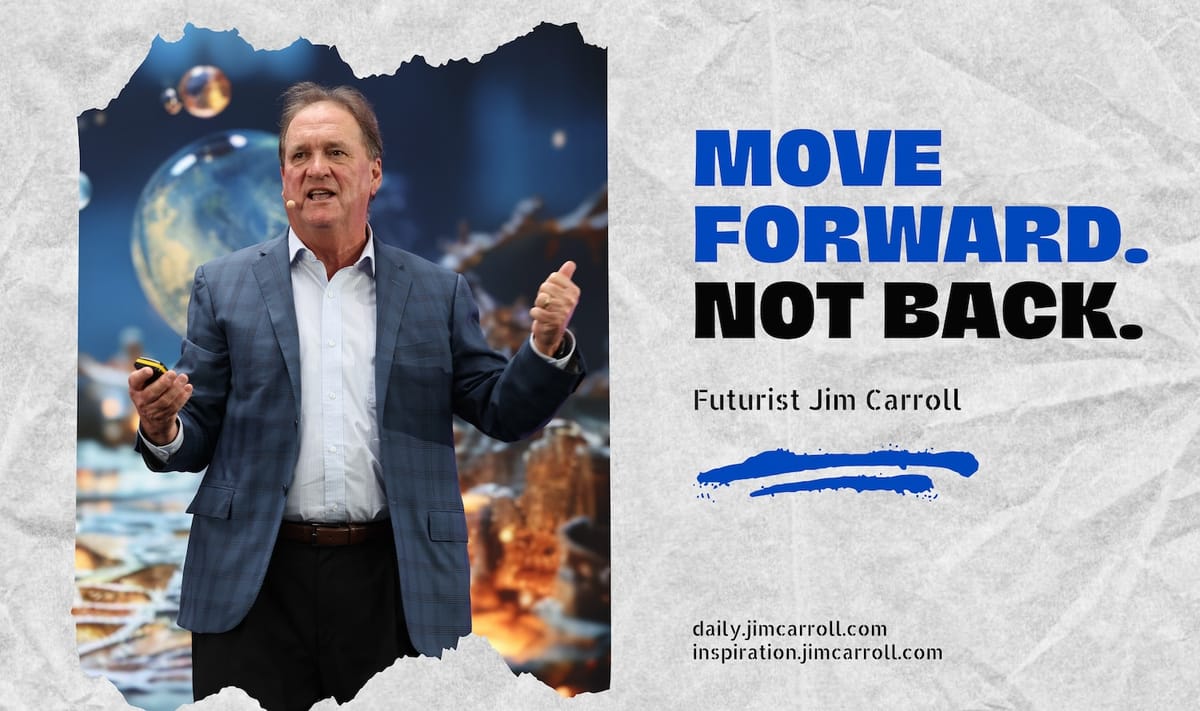"Move forward. Not back." - Futurist Jim Carroll
This particular moment in time in the news cycle - with a LOT of change occurring in the last two weeks - crystallizes much of what I have experienced from the stage in the last decade. With that being the case, there's a brief pause this week in my Being Unique series.
As someone who speaks about trends, tomorrow, and the future, I share a message about the technological, scientific, demographic, and other trends that define tomorrow. Most of it is just practical stuff - there isn't a lot of crystal-ball gazing that comes with my work, just a lot of hard-core research.
And much of what I speak about is grounded in reality. Take manufacturing - the future is all about more robotics, more advanced 'cobotics' (cooperative robots that can work side by side with humans), advanced manufacturing methodologies, and the eventual arrival of humanoid robots. It involves sophisticated new ideas such as digital twin technology, which lets us virtualize a manufacturing assembly line before its implementation, to optimize production flow, and agility-manufacturing which involves. the more rapid tear-down and rebuild of assembly lines to deal with faster product innovation. These are among dozens of other trends that completely upend the current reality in this sector.
And the fact is, there are a lot of implications of these trends involving the need for job reskilling, advanced manufacturing knowledge, and training, and new requirements at the community college level to prepare the next-generation manufacturing workforce. The same thing is happening in almost every other industry.
In that context, you can't wave a magic wand and make these realities go away; you can't chant a slogan and think that it will suddenly and instantly take this sector back to where it was. It will only go to where it is going, which is both good and bad. If an economy doesn't do the right things to prepare for these new realities, it will be mostly bad. Do the right things, and it could be great again. And right now, now, China and Asian economies are miles ahead of North America and Europe when it comes to the deployment of these new realities and doing the right things.
I wrote about this in my post back in 2021, “You can’t manufacture success from wishful thinking!” You can read it here.
The future isn’t easy – in fact, it takes a heck of a lot of hard work. But when people are being conned, they tend to ignore the reality of this advice.
Looking back to my event 5 years ago today, at a major manufacturing conference, it’s pretty obvious that my audience was starting to consume the drug that promised the buzz of the ‘the easy way out,‘ the elixir of a simple-minded just-build-a-wall-and-make-things-great-again type of thinking. Months later, the world would change as people came to cling to the belief that it was by ranting, screaming, yelling, and generally becoming that boorish neighbor that no one ever invited to neighborhood parties was a pathway to success.
Almost 10 years ago, I noticed a change in my audiences, with more and more people adopting the mindset that the future was easy and that all you had to do to chase tomorrow was to take the easy way out.
The future has a funny habit though - it moves forward, not back. It takes hard work, not slogans. It takes reinvention, not reusing old ideas. It involves complex new skills, not old ones. It takes bold moves involving massive change, not small tired steps that don't accomplish much. It involves the introduction of a lot of new ideas and acceptance of those ideas - not the rehashing and reuse of old ideas.
The future doesn't care about what happened yesterday. It will do what it needs to do tomorrow.
It always has its way with old ideas.
You have to move forward, not back.
Because you can't go back.
Only forward.
Futurist Jim Carroll has seen a lot of weird ideas about how to succeed in the future, particularly in the last 10 years.

